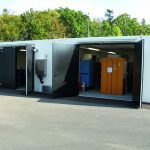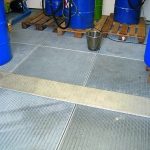Concrete is robust and resilient, making it an ideal material for safe storage of hazardous substances. cpp spoke to Paul Fricke, Managing Director of Protectoplus Lager- und Umwelttechnik GmbH, about properties, safety aspects and the advantages of walk-in or shelf-type hazardous substance stores made of concrete.
Robust and resilient concrete storage
An oasis of well-beingfor hazardous substances
Concrete is robust and resilient, making it an ideal material for safe storage of hazardous substances. cpp spoke to Paul Fricke, Managing Director of Protectoplus Lager- und Umwelttechnik GmbH, about properties, safety aspects and the advantages of walk-in or shelf-type hazardous substance stores made of concrete.
Mr. Fricke, concrete is one of the most robust and resilient materials around when it comes to safe storage of hazardous substances. What are its main advantages?
Fricke: If you’re looking for a container to store hazardous substances, you can’t go wrong with reinforced concrete constructions. Concrete is a mineral building material that meets class A1 requirements because it’s effectively non-combustible, in other words it doesn’t ignite at 1000 °C – the kind of temperature that’s likely in case of fire. And that’s not the only benefit of concrete.
What else does it have to offer?
Fricke: First and foremost, concrete is durable. The storage costs become progressively lower for every year of its life. And because concrete is so robust, any damage – for instance, if a container is hit by a forklift truck – is relatively easy to repair compared to other materials. In addition, the material properties mean the concrete body can be embedded into the ground, so that at-grade access is possible to the hazardous substance store via the integral sump tray. The customer simply has to lay the foundations slightly deeper accordingly. There are no more trip hazards as a result and no unnecessary access ramps that restrict the radius of movement in front of the doors. The risk of injury is much lower if there is nothing for people to trip over and hazardous substances can be stored much more safely. These are arguments that many of our customers find convincing because they’re aspects that play a part in the risk assessment of any hazardous substance store.
How do you achieve 90 minutes fire resistance in your concrete stores with fire protection?
Fricke: As I mentioned earlier, concrete is a mineral building material that naturally meets the requirements for class A1. We select the material thickness for the concrete body so that the stipulated 90 minutes fire resistance class is achieved. The fire protection doors conform to T90. The ducts which have to be provided through the wall, for example for inlet and exhaust ventilation or for cables and pipes, are designed to meet fire protection class K90. The complete system is thus absolutely fireproof for an hour and a half. This applies to fire loads both from the inside to the outside and from the outside to the inside. Incidentally, all components used by us which are relevant for fire protection have a valid national technical approval from the German Centre of Competence in Civil Engineering (DIBt).
Which hazardous substances are suited for your fire protection stores?
Fricke: Our concrete stores with fire protection are designed with liquid-tight steel sump trays as standard. These permit safe and regulation-compliant storage of all water-polluting substances in water hazard classes 1 to 3. Provided suitable ventilation equipment et cetera is in place, toxic substances can be stored, too. Flammable liquids (officially classified as flammable, highly flammable or extremely flammable) are also no problem as long as all electrical components are explosion-proof. Concrete hazardous substance stores are equally suited for oxidising substances or organic peroxides. In this case, we incorporate a pressure relief vent, for example – preferably in the roof – depending on the quantity involved and the OP class. Thanks to the combination of concrete’s material properties, its high compressive strength and the pressure relief vent I referred to just now, safe pressure relief is guaranteed in the event of an explosion. There’s one thing I’d like to emphasise at this point, though: no matter what the substance or the storage class, the legal regulations banning mixed storage of certain substances must be observed without fail. It’s such a complex area that my advice to anyone seeking the ideal store and the ideal equipment would be to ask the experts, like a safety specialist or the manufacturer.
What would happen if fire actually did break out in a store?
Fricke: If a fire breaks out in spite of all the precautions that are taken, any fire doors open at the time are self-closed by the fire detectors of the door stays. There’s also an anti-panic function, so that anyone still locked inside can open the door from the inside and leave the danger area without delay. The inlet and exhaust vents close, too, to prevent oxygenated air from entering the store. A fire alert is signalled either to a control room or to the fire brigade depending on the optional features that are installed, and from then on it’s up to the professional fire-fighters. Alternatively, automatic fire-extinguishing equipment can do the job instead and prevent the situation from worsening by putting out the fire rapidly.
What about environmental protection, for instance if a drum in one of your fire protection stores develops a leak?
Fricke: All our concrete stores with fire protection are fitted with a steel sump tray. The collection volume varies according to the size and the surface area. The minimum volume is determined by the maximum container size of the substances to be stored and the total storage quantity. The German Federal Water Act stipulates that, outside water conservation areas, a sump tray must be able to hold the largest container and at least 10 % of the total quantity. Special regulations that have to be considered in context apply in water conservation areas.
What requirements are specified for the sump tray material?
Fricke: The material we choose for the sump tray depends on the media. DIN 6601 defines the resistances for steel sump trays whereas if a plastic tray is used, the German Centre of Competence in Civil Engineering’s media list 40 applies. Welded sump trays are leak-tested at the factory and issued with a material test certificate. That guarantees that a tray is liquid-tight and resistant to the media it will be required to collect. Liquids collected following an accident can be properly absorbed by trained staff and disposed of if necessary. No harm comes to persons, equipment or the environment as a result.
What variants or options are available for your concrete stores with fire protection?
Fricke: We basically offer two different types of construction. In a shelf-type store, the containers can be placed directly on the grating of the integral sump tray. Staff can fill the store from the outside, without having to enter it any more. Our walk-in concrete stores, on the other hand, are designed to enable the possible grating load to be adapted for vehicle access, for example by a forklift truck. The sump tray is embedded into the ground for at-grade access without a ramp.
What sizes can you supply?
Fricke: Several components can be assembled together very easily in order to obtain a larger storage area. Stores anything from four to fifty square metres in size are possible in this way.
To wind up, have you got a few tips for our readers – points to remember if they’re planning to purchase a concrete store with fire protection?
Fricke: I really do believe that concrete is the best material for many applications. And after more than twenty years of experience, I can safely claim to be speaking from conviction. A lot of our customers have opted for the reinforced concrete version in the past, mainly because it’s much easier to repair. Concrete stores are also very popular because of the at-grade sump tray embedded into the ground, which makes the whole process more efficient. Any company planning to invest is obviously interested in ease of handling. If they keep flammable substances in an F90 hazardous substance store made of concrete, there are no safety distances to be observed. I don’t need to tell you it’s an advantage if everything is close together. The short installation time on site is another argument that customers often go for. The vast majority of construction projects realised with a concrete hazardous substance store were ready for commissioning within a day. All the equipment is manufactured almost entirely in-house, so that the time for installation on the jobsite is significantly reduced. Our customers don’t have to put up with building work disrupting operations for several weeks on end.
www.cpp-net.com search: cpp0216protecto
The majority of construction projects with a concrete hazardous substance store are ready for commissioning within a day.
Dr. Bernd Rademacher
Dr. Bernd Rademacher
Editor,
cpp chemical plants & processes
Share:









